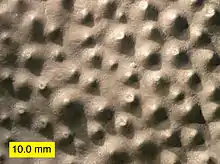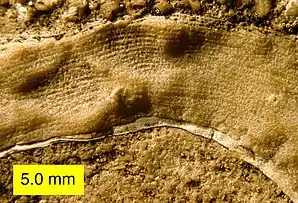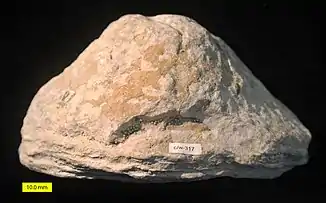Stromatoporoidea
Stromatoporoidea is an extinct clade of sea sponges common in the fossil record from the Ordovician through the Devonian. They were especially abundant in the Silurian and Devonian.[1] These invertebrates were important reef-formers throughout the Paleozoic and the Late Mesozoic. The group was previously thought to be related to the corals and placed in the Phylum Cnidaria. They are now classified in the phylum Porifera, specifically the sclerosponges. There are numerous fossil forms with spherical, branching or encrusting skeletons of laminated calcite with vertical pillars between the laminae. Specimen of its oldest genus, Priscastroma, have been found within the Middle Ordovician Sediments. This same genus has been referred to as the species P. gemina Khrom., and is known to have been known to branch off into two forms, A and B. Form A gave rise to the genus Cystostroma while form B gave rise to the genus Labechia and its descendants.[2]
| Stromatoporoidea | |
|---|---|
 | |
| Top view of a stromatoporoid showing mamelons; Columbus Limestone (Devonian) of Ohio. | |
| Scientific classification | |
| Kingdom: | Animalia |
| Phylum: | Porifera |
| Class: | Demospongiae |
| Subclass: | †Stromatoporoidea |
Stromatoporoids are useful markers whose form and occurrence can diagnose the depositional environment of sedimentary strata.[3] Paleozoic stromatoporoids hosted various symbiotic endobionts such as rugosans, syringoporids, worms and cornulitids.[4][5][6]
 Side view of a stromatoporoid showing laminae and pillars; Columbus Limestone (Devonian) of Ohio.
Side view of a stromatoporoid showing laminae and pillars; Columbus Limestone (Devonian) of Ohio. Stromatoporoids in the Devonian Keyser Formation, Pennsylvania.
Stromatoporoids in the Devonian Keyser Formation, Pennsylvania.
.jpg.webp)
References
- Stock, C.W. 2001, Stromatoporoidea, 1926–2000: Journal of Paleontology, v. 75, p. 1079–1089.
- Khromych, V. G. (2010-06-01). "Evolution of Stromatoporoidea in the Ordovician–Silurian epicontinental basin of the Siberian Platform and Taimyr". Russian Geology and Geophysics. 51 (6): 684–693. doi:10.1016/j.rgg.2010.05.009. ISSN 1068-7971.
- Da Silva, A. C.; Kershaw, S.; Boulvain, F. (2011). "Stromatoporoid palaeoecology in the Frasnian (Upper Devonian) Belgian platform, and its applications in interpretation of carbonate platform environments". Palaeontology. 54 (4): 1–23. doi:10.1111/j.1475-4983.2011.01037.x.
- Vinn, O; Mõtus, M.-A. (2014). "Endobiotic Rugosan Symbionts in Stromatoporoids from the Sheinwoodian (Silurian) of Baltica". PLOS ONE. 9 (2): 9(2): e90197. doi:10.1371/journal.pone.0090197. PMC 3934990. PMID 24587277.
- Vinn, O.; Wilson, M.A.; Mõtus, M.-A. (2014). "Symbiotic endobiont biofacies in the Silurian of Baltica". Palaeogeography, Palaeoclimatology, Palaeoecology. 404: 24–29. doi:10.1016/j.palaeo.2014.03.041. Retrieved 2014-06-11.
- Vinn, O; Wilson, M.A.; Toom, U.; Mõtus, M.-A. (2015). "Earliest known rugosan-stromatoporoid symbiosis from the Llandovery of Estonia (Baltica)". Palaeogeography, Palaeoclimatology, Palaeoecology. 31: 1–5. doi:10.1016/j.palaeo.2015.04.023. Retrieved 2015-06-18.